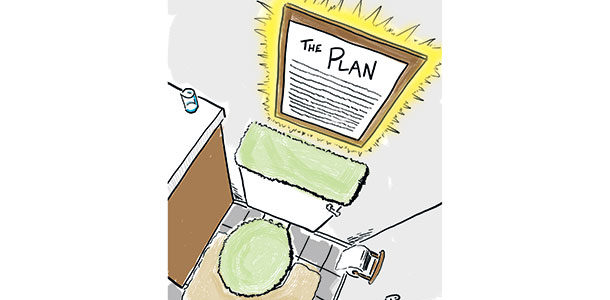I believe that every farm should have their business plan framed and hung above the toilet. Fifty years ago, farms didn’t need business plans. That is because the farm didn’t grow at that fast a rate and the biggest move you might have made in your lifetime is buying the farm next door.
Nowadays, most progressive farms are completely different every 15 years and growing at an outstanding rate. It’s the difference between a man never leaving the township and another driving to Utah. You wouldn’t need a map to go to the coffee shop across town because you’ve been there before.
However, when you are driving thousands of miles to a place you’ve never been, having a map is key in order to save time and money on gas. Having a business plan which everyone works from helps the farm family from constant bickering about direction.
Most business plans are superficial and only good for toilet paper. A lot of fluffy words that aren’t written for the redneck employees in the shop whom you are trying to motivate to actually achieve your dreams.
A business plan should be a tool used to get everyone “pulling in the same direction.” Your business plan should look like “Larry the Cable Guy” wrote the document, with words your employees would actually use (for example, get ’er done) rather than some forgettable language dictated by a Harvard Ph.D.
It should use terms you’d actually use when making decisions. It should be the kind of plain-spoken language used to decide arguments when four-letter words are being uttered.
If you can use less than seven-word mission and vision statements to guide what it is your family does and how you operate, then it’s the start of a good one-page business plan. It’s got to be something you easily remember and mutter underneath your breath just as you are about to cuss. It should be something a young lad would be willing to tattoo on his arm to remind him daily about what his purpose in life is.
For instance, one client wrote for their vision statement (what you will look like by 2025): “Three families milking 300 cows on 800 acres with less than 10 percent debt and more than 5 percent return on assets.”
For their mission statement (What you try to accomplish daily), they wrote: “Happy cows + happy accountant + happy family = success.”
Once they defined where they are going and how they are getting there, every other decision came easily. This family had been constantly bickering about every decision, from buying the farm next door to what size of equipment they needed to buy to daily decisions such as how to bed stalls for optimum cow comfort.
Remarkably, two sentences solved more than 50 percent of that family’s conflicts. These two sentences got everyone agreeing on strategic issues such as acceptable level of debt and focused on important little details like cow comfort. Even Grandpa and the dysfunctional hired man started making decisions about cow comfort from the perspective of a happier cow.
They had never thought about their return on assets before, and it inspired them to squeeze more profit out of their investments. They also started making decisions about family happiness, and for that family, it led to 2X milking instead of the madness of 3X. Before the end of the year, their profitability nearly doubled, and Christmas dinner was fun because the 163 days before, they had focused on what mattered.
Everyone has been lost on family vacations where Dad refuses to pull over for directions. The more family members in the station wagon and the longer the trip, the more tense the environment. Whenever I walk onto a farm to mediate family disputes, it’s like that.
What is key is to get everyone to agree to a plan (map) on where you are going and how you are going to get there. Even if you are off-course, it’s a one-page document which allows you to define your end goals (which everyone can agree upon) and develop a realistic plan on how you are going to get back on track.
Many farms have a big fancy 20-page business plan. It was usually written by one individual, read casually by the other farming partners and now sits in the farm’s filing cabinet. For the amount that it’s actually read and cognated, it might as well sit in the garbage.
If it’s out of sight, then it’s out of mind. If it’s out of mind, then it will never ever get done. You wouldn’t look at a map once, then go out on a 2,000-mile road trip. No, you would have it out on the truck dash at all times. Same concept. A business plan has to be a simple one-page plan you see daily in order to implement successfully.
Email me for a worksheet on how to write a one-page business plan.
I firmly believe every family farm needs a business plan, and more importantly, a business plan is only effective if it’s hung above the toilet. Yes, I did say above the toilet.
The toilet is the one place on the farm where everyone has to go and will ensure that the business plan is read daily by everyone. Being reminded several times in a day of your goals will result in changed behavior, which makes those goals become a reality.
A business plan is like a map. It helps you set your end destination and a route on how you are going to get there. If you get off-course, it helps you get back on track. When farming with multiple partners, everyone needs a one-page plan from which you navigate, or else you quickly get lost in the woods without a compass. A business plan is like a map that gets everyone pulling in the same direction. PD
Mark Andrew Junkin improves how farm families make decisions together in the years prior to farm succession. Get his book, “Farming with Family: Ain’t Always Easy!” at his website or call at (800) 474-2057.
Illustration by Fredric Ridenour.

Mark Andrew Junkin
Management Consultant







